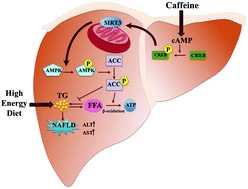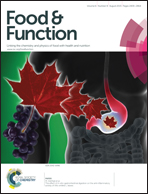Caffeine ameliorates high energy diet-induced hepatic steatosis: sirtuin 3 acts as a bridge in the lipid metabolism pathway†
Abstract
The beneficial effect of caffeine-containing food on non-alcoholic fatty liver disease (NAFLD) has been widely reported. The aim of this study was to explore the effect of caffeine on hepatic steatosis. C57BL/6 mice were randomly assigned to a normal diet or a high energy diet (HED). Caffeine was given to HED mice by oral gavage. Body weights, lipids in the liver and liver damage were measured. Meanwhile, cAMP, SIRT3 or AMPK inhibitors were treated respectively before incubation with caffeine in oleate-treated HepG2 cells. SIRT3 was further silenced by siRNA to confirm the results. Caffeine significantly decreased the mass of fat tissues, lipids, ALT and AST levels in the liver of HED-treated mice. Caffeine increased the transformation of ADP to ATP and activated the cAMP/CREB/SIRT3/AMPK/ACC pathway in the liver. Nile red staining demonstrated that suppression of cAMP, SIRT3 or AMPK in oleate-treated HepG2 cells counteracted the effect of caffeine. Moreover, knocking down SIRT3 could down-regulate AMPK and ACC phosphorylation by caffeine. These results demonstrate that caffeine could improve HED-induced hepatic steatosis by promoting lipid metabolism via the cAMP/CREB/SIRT3/AMPK/ACC pathway. SIRT3 functioned as a molecular bridge connecting caffeine and lipid metabolism.


 Please wait while we load your content...
Please wait while we load your content...